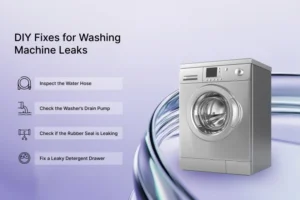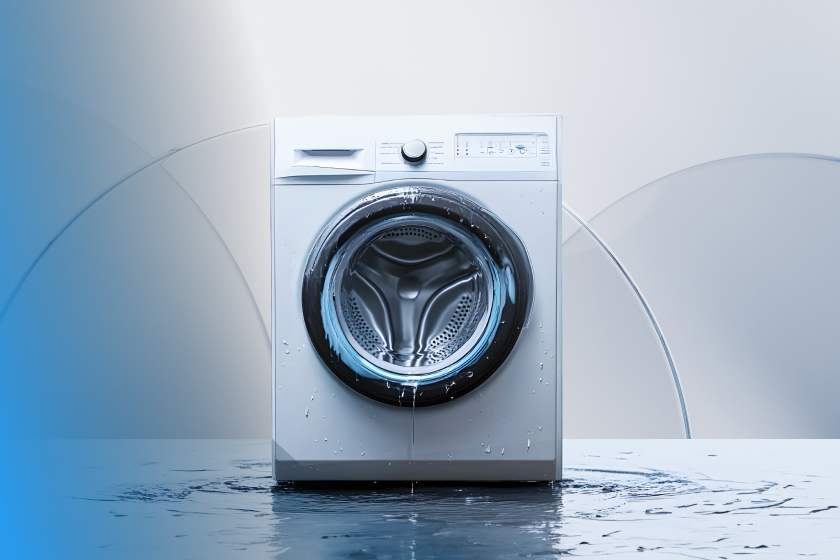Is your washing machine leaking from bottom and causing water to pool in your laundry room? A leaking washer isn’t just an inconvenience; it’s a potential threat to your home’s safety. If left unchecked, even a small leak can lead to water damage, mold growth, or costly repairs.
But what’s behind the drip? Identifying the cause doesn’t have to be a guessing game. Whether it’s a clogged drain or a worn-out seal, understanding the root of the issue is the first step to resolving it.
This blog will walk you through the most common causes and straightforward tips to fix the issue and stop leaks from happening again.
Table of Contents
Causes of Water Leaking from the Bottom of Washing Machine
A leaking washing machine from the bottom can be both frustrating and messy. Understanding the potential causes behind this issue can help you identify the problem and find the right solution quickly.
Worn-out Door or Tub Seal
Front-loading washers rely on a door seal to keep water contained. Over time, this seal may crack or tear, causing leaks from the front or bottom during cycles. Regular inspection can identify damage early and prevent your washing machine from future leakage issues.
Drain Hose Damage
Your washer’s drain hose is essential for carrying water to the plumbing system, but even minor damage can lead to leaks in the washer. This type of leakage may happen due to issues like damage, loose connections, or blockages, often causing water to escape during operation.
Regular inspections can identify cracks or tears, and replacing them right away can avoid expensive repairs.
Faulty Drain Pump
Does your washer seem to leak every time it drains? The drain pump, which expels water after each cycle, could be the reason. Cracks, wear, or loose fittings can result in dripping or significant water leakage during the draining phase. Regular inspections can help you catch these issues before they escalate.
Pressure Switch Failure
A broken pressure switch can turn laundry day into a flood disaster. When it fails, your washer doesn’t know when to stop filling, causing water to spill over and leak everywhere. Frequent checks can help you spot and fix this issue before it gets out of hand.
Water Pooling Issues
Water collecting under the drum is often caused by overstuffing the washer or a clogged, twisted drain hose. Overpacking obstructs drainage, while hose blockages make it impossible for water to flow out properly.
Too Much Use of Detergent
Overloading detergent may seem like no big deal, right? However, excessive suds can clog your machine, causing leaks during the draining cycle. These clogs not only harm your washer but also leave your laundry less fresh than you’d expect.
Easy Fixes for Washing Machine Leaking from Bottom
Before diving into repairs, make sure you’re looking in the right spot. If your washer seems to leak from the bottom, but the water is coming from the back, it might just be flowing forward. So, be sure to check both areas to find the leak’s actual source.

Inspect the Water Hose
A leaking water hose is often the simplest issue to fix. Unplug the washer first to stay safe. Pull it back slightly from the wall, and inspect the hose connections for looseness or damage. Tighten any loose fittings and look for cracks that could be the problem.
Check the Washer’s Drain Pump
For a washing machine leaking from bottom, a thorough inspection of the drain pump is essential to identify the issue. Check the hoses and clamps connected to it for any signs of looseness or damage. If you notice anything amiss, tighten the connections or replace the faulty parts to resolve the leak effectively.
Check if the Rubber Seal is Leaking
Over time, rubber seals can degrade, leading to potential leaks. Check the water hoses and their points of connection for moisture or loose fittings. If the water hose washers are damaged, you need to turn off the water and drain the hoses. Replacing all of them with new hose washers will help you avoid future issues.
Fix a Leaky Detergent Drawer
Detergent drawer leaks can often be traced back to using the wrong type of detergent or overfilling. Double-check that your detergent is compatible with your washer type, and never fill past the max line. Also, make sure you always close the drawer fully before running the machine.
Is It Worth Trying to Fix a Washing Machine Yourself?
When water leaks from the bottom of your washing machine, it can be tempting to fix the issue yourself. And in some cases, you’re absolutely right—it can be a simple DIY fix with little to no cost.
However, if the leak persists or the damage turns out to be more extensive, it’s time to call in a professional. Here’s why a technician can make all the difference in getting your washing machine back to its best condition.

-
- Safety Concerns: Handling water and electricity together can be dangerous. A technician knows how to handle these elements safely.
- Diagnosing the Leak: It’s not always clear where the leak is coming from. Professionals have the experience to pinpoint the problem quickly.
- Proper Fixes: A qualified technician can make sure the issue is fixed properly, which can save you from repeated repairs.
- Warranty Issues: DIY repairs might void your home warranty coverage for your appliance. Hence, calling an expert is safer and more cost-effective than leaving it to the pros.
Looking for the perfect home warranty plan to cover your washing machine repairs? Give us a call at 800-670-8931, and we’ll help you get the right coverage.
When Should You Consider Replacing Your Washing Machine?
Laundry can feel like a never-ending chore, but it gets even worse when your washing machine starts giving you trouble. If your washer isn’t cleaning your clothes like it used to, it could be time to think about upgrading. Here are seven signs that your washing machine may be on its way out:
-
- Loud, annoying noises that disrupt your entire laundry routine.
- Clothes aren’t coming out clean despite the wash cycle.
- The drum struggles to spin or doesn’t spin at all after a cycle.
- Frequent water leaks can cause a mess and waste a lot of water.
- Unpleasant smells that linger even after a wash.
- Increased utility bills due to an inefficient machine.
- Your washer is outdated and lacks modern features or energy efficiency.
Don’t ignore these signs, as they could save you from bigger messes, higher bills, and laundry day disasters!
Key Takeaway
A washing machine leaking from bottom doesn’t have to spell disaster. Staying proactive with regular maintenance, cleaning your washing machine, and tackling small issues before they grow bigger can go a long way. If DIY isn’t your thing or the problem persists, bringing in an expert can save you from further trouble.
A professional repair service is just a call away, especially if you have a home warranty to lean on. Take action now and keep your washer working at its best!

